Budos, Gironde, Nouvelle-Aquitaine 作者: 来源: 发布时间:2021-04-06
I. Population and Area
Total Area: 21, 1 km2 (8.14sq mi)
Population in 2017: 787
Population Density: 37/km2 (97/sq mi)
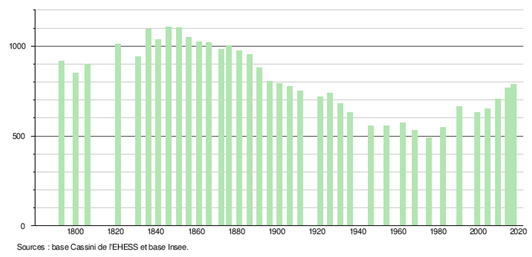
Histogram of demographic change
II. Natural Geography (environment and resources)
Municipality of the urban area of Bordeaux located near Ciron in the Graves vineyard and adjacent to the famous wine village of Sauternes. Today, the main activity of this village is viticulture.
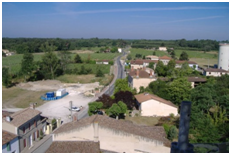
Budos is renowned for its water, as it is one of the largest sources of water in the region, water which supplies the entire south of the Urban Community of Bordeaux through an aqueduct.
The town is 42 km south-east of Bordeaux, capital of the department, 14 km west of Langon, capital of the arrondissement and 15 km south of Podensac, capital of Canton2 .
The neighboring municipalities are Pujols-sur-Ciron to the north-northeast, Bommes to the northeast, Sauternes to the east, Léogeats to the southeast, Balizac to the southwest and Landiras from the west to the north.
The town is crossed, in the village, by a common trunk road of the departmental D114 and D118, the first connecting Pujols-sur-Ciron to the northeast and Villandraut to the south, the second connecting Illats to the north and Balizac to the southwest. North of the village, the departmental road D125 leads northwest to Landiras and east to Sauternes. The municipal territory is also crossed, in the west, by the departmental road D11 which connects Saint-Symphorien in the southwest to Landiras in the northwest then Illats in the north (access to the A62 motorway).
The closest access to the A62 motorway (Bordeaux-Toulouse) is that of Exit 2 Podensac, 11 km away by road to the north.
Access Exit 1 Bazas to the A65 motorway (Langon-Pau) is located 21 km south-east.
The nearest SNCF train station is 9.5 km by road north-east from Preignac on the Bordeaux-Sète line from Aquitaine TER; that of Langon, offering more traffic, is 13 km north-north-east.
Sources : http://www.budos.fr/z/site.php?act=1_5#ad-image-example1
III. ECONOMY
Employment income (%): 75.4 (2016)
Average employment income (€):2 081 net per month (24 972 net per year) (2015)
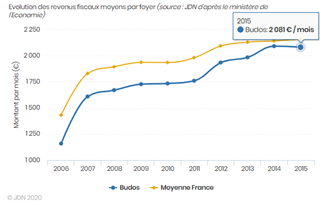
Evolution of average monthly net wages
Sources : https://insee.fr/fr/statistiques/2011101?geo=COM-33076#chiffre-cle-5
http://www.journaldunet.com/business/salaire/budos/ville-33076
IV. Industrial Characterisitics
The economy of the village is essentially based on the production of esteemed wines, classified as A.O.C. Graves (dry red and white) and Graves Supérieures (sweet white) appellation, as well as the exploitation of its maritime pine and locust forests.
Viticulture:
The town of BUDOS is located in the appellation area of "Graves" which begins a little before LANGON, very exactly in SAINT PIERRE DE MONS to end at the gates of BORDEAUX, on the left bank of the Garonne.
BUDOS is a wine-growing town located in the Graves appellation area.
The small river Ciron which rises in the Landes department separates us from the famous Sauternes wine, "Yquem" (not to name it) and many other prestigious castles.
The BUDOS wine-growing area at the beginning of the 20th century was exploited by sixty wine-growers, today 4 wine-growers share the same surface:
Château de Budos, Château Duverger, Château l'Hermitage and Château de Pouyanne.
The wines produced are reds and dry whites with "Graves" appellations.
The rosés are on the other hand of appellation "Bordeaux".

Sources:http://www.budos.fr/z/site.php?act=4_2
http://www.budos.fr/z/site.php?act=1_1
V. Attractions
1. L'église de BUDOS(BUDOS church)
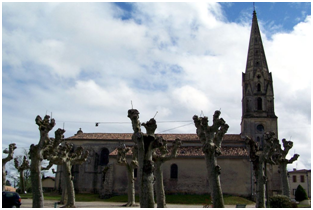
The site and the origins.
The church of BUDOS is built in the center of the village borough, which occupies a spur of land dominating a large part of theGaronne valley, to the north, and the Ciron valley (Sauternes) towards the east.
It is said that from the tip of the current bell tower, you can see 33 other bell towers around.
The construction of the building dates back to the 12th century, probably in the second half. It was at the time when ALIÉNOR wasDuchess of Aquitaine.
This church is the oldest building in the town. She is at least 120 years older than the village feudal castle, and perhapseven a little more.
Central nave
While advancing towards the Choir, on the left rises the pulpit of the 18th century, all in stone, massive and very stripped. We will find thesame, perfectly identical, in the St. MARTIN church in BOMMESOn the wall opposite, a large wooden Christ with no marked artistic interest.
The entrance to the Choir is dominated by a so-called "triumphal" arch with a basket handle. The Romanesque vault, if it ever existed, no longer appears.The thickness of the Romanesque walls surrounding the Choir (1.10 m.) could in any case have supported it.
The Master Altar and its Tabernacle surrounded by small columns are made of Pyrenean marble manufactured in BAGNÉRES de BIGORRE inthe workshop of the sculptor GÉRUZET, it was transported to BUDOS in an oxcart and inaugurated on February 17, 1846.
Behind the Master Altar, a wall built at the beginning of the 18th century, conceals the Romanesque apse. Two columns with Corinthian capitalsgilt frame a table representing SAINT ROMAIN as a fashionable bishop of the end of the 17th century, all surmounted by awooden canopy enhanced with gilding. In the center a dove symbolizing the descent of the Holy Spirit on the altar.
On either side of this set, two stucco and plaster panels representing various priestly ornaments and objects dedicated to worship(crucifix, stoles, holy water fonts, etc.). The bill is fairly naive, we will notice a number of perspective errors.
The Low Sides
The floors are covered with terracotta tiles called "Gironde" as was all the floors of the buildings until installationwood cladding in the central nave in the late 1930s.
In the central alley of the NOTRE DAME chapel (lower south side, on the right), you will notice a paving of rough stones. Theycover the graves of the Barons of La ROQUE-BUDOS, former Lords of the village and their families. The last of theseburials was that of Michel Joseph de La ROQUE in November 1770.
In the same low side, on the back wall, opposite the Notre Dame Altar, near the baptismal font, there is a large picturevery deteriorated and without much artistic value representing a Virgin and Child giving a scapular to a religious.
Below is a small gilded wooden altarpiece from the 17th century (classified) representing an Annunciation, the Virgin appearing on theleft panel and Angel Gabriel on the right panel.
The other symmetrical lower side (north side, left) houses the altar dedicated to St. PIERRE. It recalls an ancestral devotion to this Saintpatron celebrated in a chapel some ruins of which still remain about one kilometer from the village, in the forest, towardsfrom BALIZAC. The few houses located a short distance away are still called the "St. Pierre district". The cult which, at the end of aprocession starting from the parish church, was celebrated there every year on two days on June 29 and 30 was abolished in 1763. But thememories have long remained vivid in the form of a patronal feast.
In the same low side on the back wall, opposite the St. Peter altar is a wooden altar in memory of the village deadmissing in the last two wars. It was erected in 1942. Its floor covered on the left, at the foot of the inscription "Gloryto our Heroes "a huge circular stone of about 80cm, diameter pierced with a hole in its center and hermetically sealing apassage which we do not know what he can give access to. It is the mystery of the church of BUDOS and everyone, by common accord, hasalways kept the secret…
However, legends of the Crypt have run but they are not very credible because the water table is here very close under thefoundations of the building. It could well be a simple well.
The Way of the Cross was inaugurated on May 14, 1852 on the occasion of a mission preached by Marist Fathers.
Current stained glass gradually replaced partitioned glazing in grisaille between 1898 and 1903.
How long has passed, the modern era has arrived !! Several years of controls and awaiting decisions, for the restoration ofthe church that was showing real concern. In particular: the Triumphal Arch, the vault of the Nave, the cracked ceiling, the roofwith repair of the frame and the bell tower.
We are in 2001, a new team of Municipal Councilors was elected. Their first concern is to open the church ofBUDOS, closed by prefectural order for several months (about two years). New procedures, transactions and requests forsubsidies were essential for the restoration of this building. The architect Monsieur BILLA in liaison with the architect ofmonuments de France will finally start the consolidation and repair work (in three installments).
2. Château de Budos (Budos Castle)
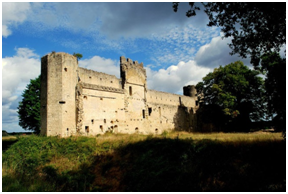
Budos Castle. Budos houses the ruins of a fortified castle from the fourteenth century, altered in the sixteenth century. It was built by Pope Clement V's nephew, Raymond Guilhem de Budos, shortly after the construction of the Château de Villandraut, in 1305. Each year, parties around different themes are organized within its precincts.
3. Le lavoir du bourg (The washhouse of the village)
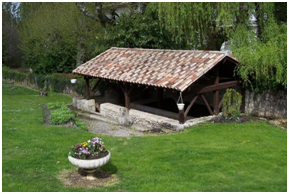
The municipal wash house, intended for washerwomen, is built on a source which supplies it with water on a regular basis.
Installed in the corner of two walls, it consists of a two-pitched roof resting on a wooden frame itself supported by poles of the same material. The washhouse was restored and its roof redone during the 20th century.
Sources :http://budos.fr/upload/patrimoine/eglise.pdf
https://fr.wikipedia.org/wiki/Ch%C3%A2teau_de_Budos
VI. History
To the north-west of the village is a wooded mound, with bushy thickets, the Tuco de la motte, forty meters in diameter at the base, which dominates the Tursan valley. There is no indication to indicate whether it is a protohistoric mound or a feudal mound as indicated by the toponym.
In the Middle Ages, the history of Budos merged with that of its castle and the lordship.
For the state of the town in the 18th century, here is what Jacques Baurein's investigation says:
This parish, made up of around two hundred lights, has a small town located on the hill and some villages: Pinguoy, Perron, Cosson, Mouliés, Paulin, Corpia and Peyrouse, named so because of the quality of its sound. soil, which is stony.
The terrain is generally light and sandy; its main productions are wheat, wine and millet. Its inhabitants only take care of the cultivation of the land. There is also a pine wood and a moor of about eighteen hundred newspapers, which belongs to the inhabitants.
There is, notes J. Baurein, at the foot of the castle, a remarkable fountain, the course of which is equal in all seasons, and whose water flows with enough abundance to make turn, with little distance, a mill with three millstones. The stream it forms will flow into the Ciron. On another tributary of the Ciron, the Tursan stream, there is a wooden bridge which allows communication with Bommes; but "this bridge is only for people on foot or on horseback, and not for carts".
Mail must be sent to the Preignac post office, route de Langon, via the Grande Poste.
During the Revolution, the Saint-Roman parish of Budos formed the town of Budos.
In the nineteenth century, Rebsomen points to the former noble house of Margaride and the sources of Fonbanne, famous for their abundant and clear water, "whose flow is 350 liters per second. These waters have been brought to Bordeaux since 1887 by an aqueduct 41 kilometers long”.
Just before the Magdelainebridge over the Ciron, was a small building in ruins, under the trees and in a very picturesque corner: rectangular enclosure built in beautiful stone, called the chapel of the Magdelaine.
The Second Empire:
A real entrepreneurial frenzy is manifesting. In just a few years, we redraw the village paths, we trace new roads, we build the church bell tower, we build a new presbytery, we build the village square by moving the cemetery, we draw up maps of 'a school that we will not have time to build. The Third Republic will take care of it. We also fight unemployment thanks to "charity workshops". The hitherto uncultivated and desolate moor has been sown with maritime pines and is beginning to bring significant economic support to the life of the village.
The good times(La belle époque):
The village has a very active economic life.
There are many small businesses and artisans.
A stone quarry, two sawmills, two dairies, three blacksmiths, two blacksmiths, two bakeries, two grocery stores, a saddler saddler, a weaver, a tailor, a shoemaker, etc. ...
It's the whole life of a pre-war village.
Sources:http://www.budos.fr/z/site.php?act=1_2
VII. Other information
In the borough of BORDEAUX, in the canton of PODENSAC, the municipality of BUDOS covers an area of 2,109 hectares for a population of 710 inhabitants (the Budossais).
This commune is located astride the crest line forming the extreme limit of the left bank of the Garonne, its northern slope, Garonne side, is essentially dedicated to the cultivation of the vine and, in its lowest part, to a beautiful forest of locust trees (or false acacias) established on land formerly, also, viticultural, but which were not rehabilitated after the serious crisis of phylloxera at the end of the XIXth century. Its southern part develops over the first large areas of the LandeGirondine dedicated to maritime pine forestry. Finally, a wetland, of a rich plant variety occupies the left bank of the Ciron, a tributary of the Garonne and marking, to the east, the limits of the town.
The village village is located on a spur overlooking the Garonne valley to the north and the Ciron valley to the east. Due to this privileged location, the view extends from there to the hills of SAINTE CROIX DU MONT and all over the famous country of Sauternes.
Within the village rises its 12th century church, several times altered over time, but which has preserved its Romanesque chevet intact.
Halfway down the hill stand the imposing ruins of a medieval castle built by a lord of BUDOS, nephew of Pope CLÉMENT V.
At the bottom of the same hill, an industrial site now masks the very significant resurgence of BUDOS sources captured in 1887 for the benefit of the city of BORDEAUX. The waters are led there by an aqueduct with a length of 41 kilometers and still provide an appreciable part of the needs of the agglomeration.
Sources :http://www.budos.fr/z/site.php?act=1_1
VIII. Contact information
Budos town hall address :
Mairie de Budos, 5 rue du Château, 33720 Budos
Mayor :Élie Zausa (Mandate : 2014-2020)
Phone number: 05 56 62 51 59
Fax: 05 56 62 43 31
Mail: mairie.budos@wanadoo.fr
Website :http://www.belin-beliet.fr
Sources :http://www.cartesfrance.fr/carte-france-ville/33076_Budos.html#mairie
